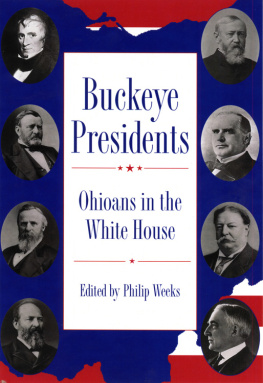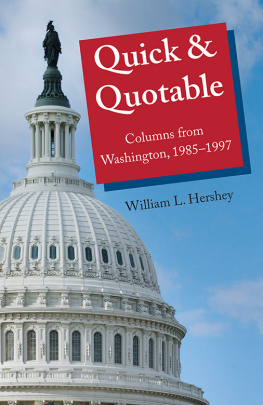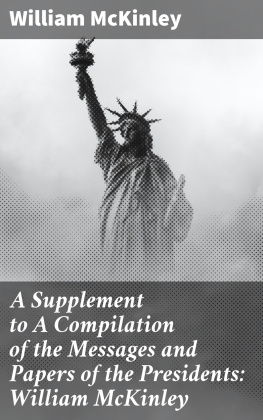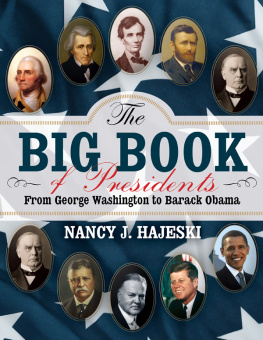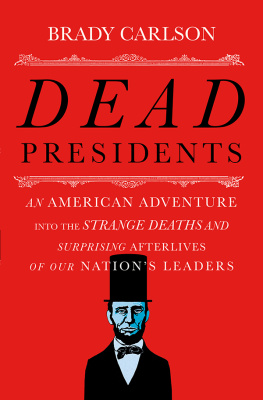
Buckeye
PRESIDENTS
Edited by
PHILIP WEEKS
Buckeye
PRESIDENTS
Ohioans in the White House
THE KENT STATE UNIVERSITY PRESS
Kent and London
2003 by The Kent State University Press, Kent, Ohio 44242
All rights reserved
Library of Congress Catalog Card Number 2002003879
ISBN 978-0-87338-727-9
Manufactured in the United States of America
This is an on-demand reprint of the first edition published
in 2003 by The Kent State University Press
Library of Congress Cataloging-in-Publication Data
Weeks, Philip.
Buckeye Presidents: Ohioans in the White House / Philip Weeks
p. cm.
Includes bibliographical references and index.
ISBN 0-87338-727-9
1. PresidentsUnited StatesBiography.
2. OhioBiography.
I. Weeks, Philip. II. Title.
E176.1 .W366 2002
973.099dc21
2002003879
British Library Cataloging-in-Publication data are available.
D edicated gratefully
to Jerome Mushkat, who better than anyone else
taught me about, and demonstrated to me
how to teach and convey,
the sum and substance of United States history.
As always,
for Jeanette and Michael. And to Heather.
And C. C., you were always there with a smile,
then you slipped away so quickly.
Contents
PART I
THE EARLY REPUBLIC
William Henry Harrison
KENNETH R. STEVENS
PART II
SECTIONAL CONFLICT, WAR, AND PEACE
Ulysses S. Grant
BROOKS D. SIMPSON
Rutherford B. Hayes
ARI HOOGENBOOM
James A. Garfield
JOHN B. SHAW
Benjamin Harrison
GEORGE W. GEIB
PART III
FROM GILDED AGE TO ROARING TWENTIES
William McKinley
H. WAYNE MORGAN
William Howard Taft
JUDITH I. ANDERSON
Warren G. Harding
THOMAS C. SOSNOWSKI
The Mother of U.S. Presidentsan impressive claim, and one that applies legitimately to only two of the nations fifty states, Ohio and Virginia. Between them they have provided the republic with fifteen of its presidents. One of the fifteen, William Henry Harrison, is a hybrid who is properly associated with both Ohio and Virginia. His experience reflected that of many Americans during the early decades of U.S. history: born in one of the thirteen British colonies, grew up during the tumultuous Revolutionary era, and then in early adulthood relocated beyond the Appalachian chain to settle and pursue a new life in Americas first West. In addition to Harrison, seven Ohioans have piloted the United States from the White House: Ulysses S. Grant, Rutherford B. Hayes, James A. Garfield, Benjamin Harrison, William McKinley, William Howard Taft, and Warren G. Harding. An equal number of Virginians have been the nations chief executive: George Washington, Thomas Jefferson, James Madison, James Monroe, William Henry Harrison, John Tyler, Zachary Taylor, and Woodrow Wilson.
The presidents associated with Virginia and Ohio directed the affairs of the United States during two critical eras. During the nations formative period, from the birth of the federal republic in the 1780s through 1850 and the mounting hostility between North and South, seven of the nations twelve presidents were from the Old Dominion. In the six decades following 1865 and the end of Americas Civil War, as modern America emerged, seven of the nations twelve presidents were Buckeyes. Each helped guide the United States in its transformation from a rural, agrarian, diplomatically isolationist society into a wealthy and powerful commercial and industrial nation, one that became an increasingly major player in global geopolitics. Ohio was so dominant and maintained such a compelling hold on national and presidential politics from the Civil War through World War I that when Republican Warren G. Harding of Marion ran for the presidency in 1920 his opponent was none other than another Ohioan, Democrat James Cox of Dayton.
All eight Buckeye presidents were consequential participants in state and national affairs prior to their ascendancy to the White House. Four were governors of states or territories: William Henry Harrison (Indiana), Rutherford B. Hayes (Ohio), William McKinley (Ohio), and William Howard Taft (Philippines). Six served in the U.S. Congress: William Henry Harrison, Hayes, James A. Garfield, Benjamin Harrison, McKinley, and Warren G. Harding. Six of the eight also had military service. Five were generals in the U.S. Army: William Henry Harrison, Ulysses S. Grant, Hayes, Garfield, and Benjamin Harrison (McKinley had a lesser rank, rising from private to major during the Civil War). To make a living outside of government, some were attorneys (Hayes, Benjamin Harrison, McKinley, and Taft), others were college professors (Garfield, Benjamin Harrison, and Taft), one was an editor and publisher (Harding), and another was a farmer and a store clerk (Grant). Taft, subsequent to his White House years, became chief justice of the U.S. Supreme Court, making him the only American to hold the top post in two of the three branches of the U.S. government. The average age of these eight men upon taking the presidential oath was fifty-four. The youngest was Grant, who was forty-six; the oldest was William Henry Harrison, at sixty-eight, the last president born a British subject. Four of the eight Buckeye presidents did not live to see the conclusion of their terms: William Henry Harrison and Harding died of natural causes while in office, and assassins killed Presidents Garfield and McKinley.
Buckeye Presidents is introductorynot definitive, illustrativenot encyclopedic. It seeks to provide general readers and students with an overview of significant aspects of the lives and times of eight men from Ohio who each became the president of the United States. The book draws on the expertise of eight specialists who have written chapters profiling these chief executives. Of specific value, each chapter presents a synthesis of the authors reflection on recent scholarship about his or her subject and scholarship during the era in which the president lived, as well as the authors own area of academic competence. In most instances, the author of the chapter brings the experience of having already published an important biography about their subject. Each scholar has also included a section of suggested readings, which is placed at the end of his or her chapter; these recommendations will aid readers who wish to expand their knowledge of these eight presidents and their America.
I would like to express my appreciation to the authors for taking time out of their demanding professional schedules to participate in this endeavor. It was a pleasure to work with Joanna Hildebrand Craig of The Kent State University Press as she moved this book to publication. And it is wonderful to have the opportunity again to salute in print my best friend, my wife Jeanette, especially at the time of our thirtieth anniversary.
PART I
The Early Republic
The National Story
On the morning of April 30, 1789, a large crowd gathered outside Federal Hall in New York City. Standing on the buildings porch, George Washington put his hand on a Bible and was asked, Do you solemnly swear that you will faithfully execute the office of President of the United States, and will to the best of your ability, preserve, protect and defend the Constitution of the United States? I solemnly swear, he replied. With that, the first president of the United States took office, and a new era in the nations history began. Installing a smoothly operating national authority, establishing a workable federal court system, and addressing the countrys economic problems occupied the federal government during Washingtons first term. Foreign affairs became the most important concern for Washington during his second term, and it remained central for the first three chief executives who succeeded him: John Adams, Thomas Jefferson, and James Madison.

